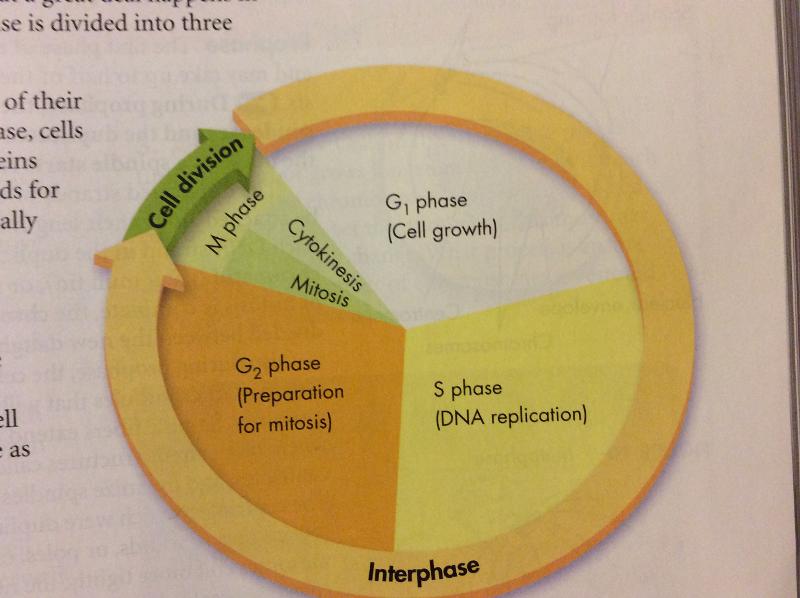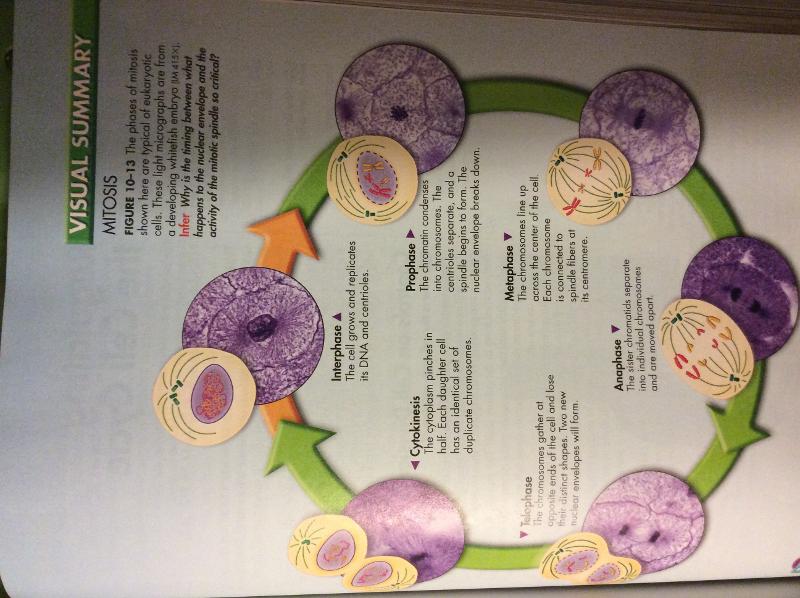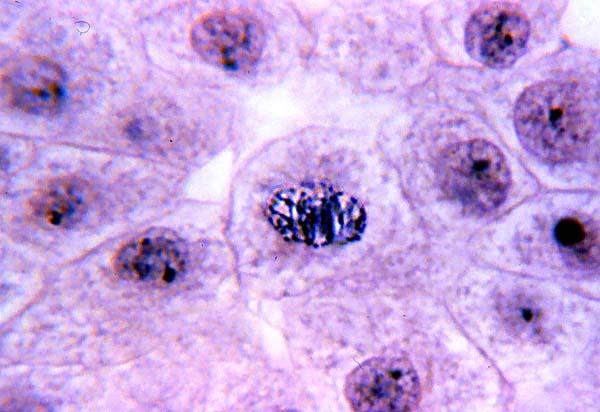Why does a cell divide because of its size?
1. DNA doesn't grow with the cell, so as the cell gets larger, it demands more of DNA. To reduce strain, a cell must not grow anymore
2. Cells lose efficiency if too large because waste and nutrients do not move across the cell membrane.
Define Interphase (basic idea)

The "in between growth of a cell". There are 3 parts: G1, S, G2
Describe G1 phase (interphase)
Phase of cell growth.
Cell increases in size.
Cell synthesizes new proteins and organelles
Describe S Phase (interphase)
DNA replication.
DNA is synthesized and chromosomes are replicated.
2x the DNA
Describe G2 Phase (interphase)
Preparing for cell division.
Shortest of the phases
organelles and molecules for division are produced
what is the M Phase that follows interphase?
It is the cell division
follows interphase
produces 2 daughter cells. Consists of mitosis and cytokinesis
Mitosis

1st stage of cell division. It's the division of the cell nucleus. There are 4 phases
Mitosis: Prophase
Usually the longest
genetic material inside nucleus condenses and duplicated chromosomes become visible.
outside the nucleus, spindles begin to form
centromere
Where duplicated DNA molecules attach along their length
sister chromatid
Each DNA strand in the duplicated DNA chromosome
centrioles
Where spindles extend from in animal cells.
Mitosis: metaphase
Usually the shortest phase.
sister chromatids line up in the middle of the cell.
centrioles are at opposite ends, spindles connect to the centromes
mitosis: anaphase
Sister chromatids separate and move apart.
each sister chromatids is now considered an individual chromosome
chromosomes move to opposite ends of the cell
anaphase ends when the movements stops and the chromosomes are completely separated.
Mitosis: telophase (final phase)
Chromosomes begin to spread into tangle of chromatin
nuclear envelope reforms around each cluster of chromosomes
spindles begin to break a part
nucleus becomes visible in each daughter cell
mitosis is complete
Cytokinesis
Result of mitosis
splitting of 1 cell into 2.
Difference between plant and animal cells in cytokinesis?
Animal cells get furrows, and cytoplasm is eventually pinched into two equal parts. In plant cells, first a cell plate forms. Nucleus separates. Then a cell wall forms.
Genome
All the DNA in a cell
What is DNA packaged into?
Chromosomes
chromatin
Complex of DNA & protein that condenses during cell division
Somatic cells
Unreproductive cells
46 chromosomes!
Gametes
Reproductive cells
have 1/2 as many chromosomes as somatic cells
they have 23 chromosomes!
G 0 Phase
Most cells are in this phase. These cells are not replicating. Some cells never leave this phase! Like Nerve cells, heart cells.
Aster
Array of short microtubules extends from each centrosome
What does a Spindle include?
Centrosomes
spindle microtubules
the asters
kinetochores
proteins attached to centromere that links sister chromatids to mitotic spindle
part of the mitotic spindle
What is the importance of the G1 checkpoint in Interphase?
Provides the stop / go ahead signal that tells a cell to split, or not to split.
CDK
cyclin dependent kinase, adds phosphate to a protein), along with cyclins, are major control switches for the cell cycle, causing the cell to move from G1 to S or G2 to M.
What are the 2 types of regulatory proteins involved in cell cycle control?
Cyclin & Cyclin-dependent kinases (cdks) (this is an enzyme)
MPF (maturation-promoting factor) is a cyclin-cdk complex that triggers a cells passage from ___ to ___ phase
from G2 phase to M phase.
HeLa Cells
cancer cells from Henrietta that never stop replicating. They are used in research
What enables a cancer cell to grow?
It does not receive any signals to stop. It is uncontrollable regulation.
How do prokaryotes reproduce?
binary fission
binary fission
cell division in prokaryotes
the chromosome replicates and then 2 daughter chromosomes actively move apart.
the plasma membrane pinches inward, dividing the cell in 2
genetics
the scientific study of heredity and variation
heredity
the transmission of traits from one generation to the next
variation
is demonstrated by the differences in appearance that offspring show from parents and siblings
locus
a gene's specific location on a certain chromosome
gametes
reproductive cells (sperm & egg)
Gametes are Haploid! (23 chromosomes)
asexual reproduction
a single individual passes genes to its offspring without the fusion of gametes
life cycle
the generation to generation sequence of stages in the reproductive history of an organism
*males are always in life cycle. females exit at menopause
From conception to time one reproduces!
How many pairs of chromosomes do human somatic cells have?
23 pairs
23 from mom & 23 from dad
homologous chromosomes
the two chromosomes in each pair of somatic cells
* chromosomes in a homologous pair are the same length and carry the same inheritable traits
karyotype
ordered display of the pairs of chromosomes from a cell
autosomes
the chromosomes in a human that are not the sex chromosomes
diploid cell
has 2 sets of chromosomes. (2n)
for humans - the diploid # is 46 (2n = 46)
somatic cells are diploid
Meiosis reduces the number of chromosome sets from ___ to ___
diploid to haploid
meiosis results in ___ daughter cells
4
reductional division
Meiosis I results in 2 haploid daughter cells with replicated chromosomes
equational division
Meiosis II results in 4 haploid daughter cells with unreplicated chromosomes

What phase is this?
Mitosis - Interphase

What phase is this?
Mitosis - prophase

What phase is this?
anaphase - mitosis

What phase is this?
metaphase - mitosis

What phase is this?
mitosis - telophase

What phase is this?
mitosis - cytokinesis
What is a tetrad 4?
The homologous chromosomes in Meiosis 1, each a pair of sister chromatids, join up to form a tetrad
chiasma
x shaped regions in Meiosis 1, where crossing over occurs
recombinant chromatids
breaking & rejoining at the chiasma in Meiosis 1
In metaphase 1, ___ line up at the metaphase plate
tetrads
Anaphase 1 separates _____
homologous chromosomes
At the end of meiosis there are...
4 non-identical daughter cells
each with a HAPLOID set of unreplicated chromosomes
synapsis
homologous chromosomes loosely pair up, aligned gene by gene
What 3 events are unique to Meiosis and ALL occur in Meiosis 1?
- synapsis & crossing over in Prophase 1 (homologous chromosomes physically connect and exchange information
- in metaphase, there are tetrads instead of individual replicated chromosomes
- Anaphase 1 homologous chromosomes separate, not sister chromatids
When does DNA replication occur in Mitosis and Meiosis?
during interphase
How many divisions occur in mitosis and meiosis?
Mitosis = 1
Meiosis = 2
How many daughter cells occur after mitosis, and what is their genetic composition?
2 - each are identical to the parent cell, with the same number of chromosomes
How many daughter cells occur after meiosis, and what is their genetic composition?
4 - each haploid; genetically different from parent cell AND each other
allele
is one of two or more versions of a gene. An individual inherits two alleles for each gene, one from each parent.
What are the 3 mechanisms that contribute to genetic variation?
- independent assortment of chromosomes
- crossing over of chromatids
- random fertilization
What is the independent assortment of chromosomes?
- they orient randomly at metaphase 1
- either the maternal or paternal can go to the daughter cell
Crossing over produces _______ which combine DNA inherited from each parent
recombinant chromosomes
How do the sugars in DNA pair up? (C -A - T - G)
C - G
T - A
The sugar in DNA is
deoxyribose
The sugar in RNA is
ribose
What are the 3 major differences between RNA & DNA
DNA: double strand, has thymine (t), and deoxyribose
RNA - single strand, has uracel (u), and ribose
How do Viruses spread?
They inject their DNA into a host cell in order to replicate and produce more.
Chargaff's Rule
A bases = T bases & G bases = C bases
If asked to solve a question like -
A+C=T+G or A+G = T+C
Then you should use hypothetical numbers for the nucleotides
Example:
A = 10, Thus T = 10
C = 20, thus G = 20
Plug & Solve:
A+C = T + G
10+20 = 10+20
As long as the equation equals, then the variables above work in the combination given. Example of NOT working:
A+T = C+G
10+10 = 20+20
What kind of bonds hold DNA strands together?
hydrogen bond
DNA pairs ___ with ____
Purine with a pyrimidine
DNA replication begins...
at the origin of replication
It can only elongate in the 5 prime - 3 prime direction
Replication proceeds in ____ directions from each origin until the entire molecule is copied
both
Replication Fork
located at each end of the replication bubble. This is where new DNA strands are elongating.
helicases
are enzymes that untwist the double helix at the replication forks
single-strand binding proteins
bind to and stabilize single stranded DNA until it can be used as a template
topoisomerase
corrects overwinding ahead of replication forks by breaking, swiveling, and rejoining DNA strands
DNA can only be added to __ prime end
3
Primer
- A primer is a strand of short nucleic acid sequences (generally about 10 base pairs) that serves as a starting point for DNA synthesis. It is required for DNA replication because the enzymes that catalyze this process, DNA polymerases, can only add new nucleotides to an existing strand of DNA.
Primase
enzyme starts an RNA chain and adds RNA nucleotides one at a time using the parental DNA as a template
The primer is short - and the 3' end serves as the starting point fro the new DNA strand.
DNA Polymerases
catalyze the elongation of new DNA at a replication fork.
Most require a primer & DNA template strand
Nucleotide triphosphate
each nucleotide that is added to a growing DNA strand
DNA can only elongate in the
5' to 3' direction BECAUSE nucleotides are added only to the free 3' end of a growing strand
the DNA polymerase synthesizes a _______ continuously toward the replication fork.
leading strand
to elongate the other new strand, the _____, DNA polymerase must work in the direction away from the replication fork.
lagging strand
Okazaki fragments
synthesize the lagging strand segments which join them together through DNA Ligase
mismatch repair of DNA
repair enzymes correct errors in base pairing
DNA can be damaged by...
chemicals, radioactive emissions, X-rays, UV light, and certain molecules (like in cigarette smoke)
nucleotide excision repair
a nuclease cuts out and replaces damaged stretches of DNA
telomeres
postpone the erosion of genes near the ends of DNA
*Like junk DNA, no specific coding for function
*May be connected to how we age
telomerase
enzyme that catalyzes the lengthening of telomeres in germ cells
a chromosome consists of a _____ packed together with ____.
DNA molecule; proteins
chromatin
complex of DNA and protein, found in the nucleus of eukaryotic cells
Organized in fibers
ribosomes
They are the sites of translation.
they consist of rNA and proteins. They are assemble proteins of the cell;
free floating or bound
What sugar is on RNA that is not on DNA?
Uracil
Proteins are the links between ____ & ____.
genotype & phenotype
genotype
genetic make up of an organism
phenotype
observable differences of an organism determined by genetics and environmental factors
Alleles
Alternative forms of the same gene that occupy the same location on a chromosome.
*At any given locus, there are 2 (1 on each chromosome in the pair) – you get 1 a from your mother and 1 from your father.
RNA
bridge between genes and the proteins for which the code
What is transcription?
the synthesis of RNA, directed by DNA - this produces mRNA
mRNA
Messenger RNA
What is translation of RNA?
synthesis of a polypeptide from amino acids, under the direction of mRNA
What is central dogma?
the concept that cells are governed by a cellular chain of command
DNA --> RNA --> to protein
Describe the Transcription in Prokaryotes.
DNA ---> mRNA ---> Ribosome
Describe the Transcription process in Eukaryotic Cells
DNA ---> Pre mRNA ---> mRNA ---> leave nucleus ---> ribosome ----> then to protein
What is involved in RNA Synthesis?
RNA synthesis is catalyzed by RNA Polymerase, which pries the DNA strands apart and hooks together the RNA nucleotides
Promoter
The DNA sequence where RNA polymerase attaches
They signal the transcriptional start point
transcription unit
stretch of DNA that is transcribed ; a gene
What are the 3 stages of RNA Transcription
1. Initiation
2. Elongation
3. Termination
transcription factors
mediate the binding of RNA polymerase and the initiation of transcription
What happens in the elongation of the RNA strand?
- as polymerase moves along the DNA, it untwists the double helix
- nucleotides are added to the 3' end of the growing RNA molecule
What is the termination of transcription?
Eukaryotes: the polymerase continues transcription after the pre-mRNA is cleaved from the growing RNA chain; the polymerase eventually falls off the DNA
Why are the ends of mRNA altered?
- They seem to facilitate the export of mRNA
- They protect mRNA from hydrolytic enzymes
- They help ribosomes attach to the 5' end
How are the ends of mRNA altered?
5' cap at one end and a poly tail at the other
RNA Splicing
removes introns and joins the exons - creating an mRNA molecule with a continuous coding sequence.
[cap] - [intron] - [exon] - [intron] - [exon] - [AAAA]
introns
junk DNA. They don't code for anything
exons
hold the code on mRNA. Left in sequence to be read after the introns are spliced out
spliceosomes
made of a variety of proteins & several small nuclear ribonucleoproteins (snRNPs) that recognize the splice sites
Alternative RNA Splicing
can make multiple proteins from 1 gene depending on what is spliced out of the sequence
Ribozymes
catalytic RNA molecules that function as enzymes and can splice RNA
Once DNA is transcribed to mRNA (messenger RNA), what are the characteristics of the instructions?
- portable - can leave the nucleus
- edited - (processed; only exons)
- multiplicable (can make multiple mRNAs at a time
- Temporary - mRNA degrades when need passes
How are the instructions for assembling amino acids into proteins encoded in DNA?
Genetic Code
What is a codon?
How information is ordered in RNA that is used to translate what protein should be made.
Codons are grouped in 3's
**determines what protein is to be made
tRNA
Transfer RNA - brings the correct Amino Acid to the Codon
anticodon
on the tRNA. Its the complementary to the codon on the mRNA
How many binding sites does tRNA have?
3
P
A
E
Describe the process of P A E on the tRNA
a = holds the tRNA that carries the next Amino Acid to be added to the chain
p = holds the tRNA
e = exit site from which tRNA leaves
Where do free ribosomes proteins go?
they function in the cytosol
Where do proteins go that are made in bound ribosomes?
endomembrane system OR they are secreted from the cell
What are the types of point mutations?
1. base-pair substitutions
2. base - pair insertions or deletions
Nucleotide - pair substitution
replaces one nucleotide and its partner with another pair of nucleotides
silent mutations
have no effect on the amino acid produced by a codon because of the "extra" 3rd spot on the codon
missense mutation
still code for an amino acid - but not the right one
nonsense mutations
bad! these change the amino acid codon into a stop codon. No proteins are then made
independent assortment
stating that when two or more characteristics are inherited, individual hereditary factors assort independently during gamete production, giving different traits an equal opportunity of occurring together.